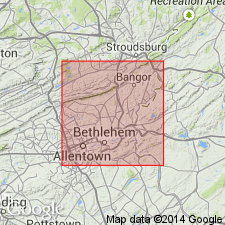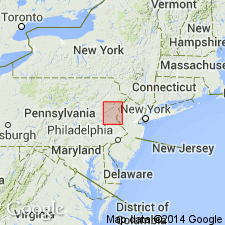
- Usage in publication:
-
- Leithsville formation
- Modifications:
-
- Named
- Dominant lithology:
-
- Dolomite
- Shale
- AAPG geologic province:
-
- Appalachian basin
Summary:
Leithsville formation in the Lehigh Valley district of PA described as gray dolomite with abundant sandy and cherty layers and buff-colored shale beds. Thickness is 1,500 ft. Underlies Allentown limestone and overlies Hardyston quartzite. Assigned to Middle and Lower Cambrian.
Source: GNU records (USGS DDS-6; Reston GNULEX).

- Usage in publication:
-
- Leithsville†
- Modifications:
-
- Abandoned
- AAPG geologic province:
-
- Appalachian basin
- Piedmont-Blue Ridge province
Summary:
Leithsville formation is abandoned and Tomstown formation extended to area as substitute.
Source: GNU records (USGS DDS-6; Reston GNULEX).

- Usage in publication:
-
- Leithsville formation
- Modifications:
-
- Reinstated
- AAPG geologic province:
-
- Appalachian basin
- Piedmont-Blue Ridge province
Summary:
Reinstated the Leithsville limestone since use of name Tomstown implies unwarranted correlation with Tomstown type area. Also used in place of Elbrook limestone in Buckingham Valley. Described as mostly dark gray-blue to black dolomitic rock with yellowish to buff beds. Variable bedding and lithologic characteristics. Includes thin-bedded impure high magnesium limestone; argillaceous sericitic shaly limestone to sericitic shale lacking carbonate; and massive dense dolomite limestone in beds up to 10 feet thick. Also contains masses of dark or light chert. Overlies Chickies quartzite in Buckingham Valley and disconformably overlies Hardyston quartzite in Lehigh Valley, and underlies Limeport limestone. The Leithsville is of Early, Middle, and Late(?) Cambrian age.
Source: GNU records (USGS DDS-6; Reston GNULEX).

- Usage in publication:
-
- Leithsville formation*
- Modifications:
-
- Areal extent
- AAPG geologic province:
-
- Piedmont-Blue Ridge province
Summary:
Geographically extended the Leithsville formation to western NJ. Consists of dark-gray, buff-weathering dolomitic limestone, and sericitic limey clay-shale, in places phyllitic. Thickness is estimated at 800 to 900 feet. Overlies Hardyston quartzite and unconformably underlies Triassic rocks. The Leithsville is of Middle(?) Cambrian age.
Source: GNU records (USGS DDS-6; Reston GNULEX).

- Usage in publication:
-
- Leithsville Member
- Modifications:
-
- Revised
- AAPG geologic province:
-
- Piedmont-Blue Ridge province
Summary:
Revised the Leithsville to a member of the Kittatinny Formation in northwestern NJ. Consists of blue-gray dolomite and shale. Thickness is about 1,000 feet. Overlies Hardyston Formation and underlies Allentown Member of Kittatinny.
Source: GNU records (USGS DDS-6; Reston GNULEX).

- Usage in publication:
-
- Leithsville Formation
- Modifications:
-
- Revised
- AAPG geologic province:
-
- Appalachian basin
- Piedmont-Blue Ridge province
Summary:
Subdivided the Leithsville Formation in northwestern NJ into the (ascending) Califon, Hamburg, and Wallkill Members. The Califon Member is 40 to 150 feet of fossiliferous dolomite, the Hamburg Member is 85 to 100 feet of sandstone, shale, siltstone, and dolomite, and the Wallkill Member is 400 to 500 feet of dolomite. The Leithsville is 500 to 800 feet thick, overlies the Hardyston Formation, and underlies the Allentown Formation.
Source: GNU records (USGS DDS-6; Reston GNULEX).

- Usage in publication:
-
- Leithsville Formation*
- Modifications:
-
- Age modified
- AAPG geologic province:
-
- Appalachian basin
- Piedmont-Blue Ridge province
Summary:
The age of the Leithsville Formation in eastern PA and western NJ is changed from Middle(?) Cambrian to Early and Middle Cambrian.
Source: GNU records (USGS DDS-6; Reston GNULEX).

- Usage in publication:
-
- Leithsville Formation
- Modifications:
-
- Overview
- AAPG geologic province:
-
- Appalachian basin
- Piedmont-Blue Ridge province
Summary:
The Leithsville Formation in the Lehigh Valley sequence of PA consists of medium- to dark-gray, some light-olive-gray, light-gray and yellowish-brown weathering, massive bedded, oolitic, crystalline dolomite with pink to gray mottled chert and dark-gray chert. Also contains thin shale and dolomitic shale interbeds, scattered sand grains, and is very shaly in the upper part. Overlies the Hardyston Formation and underlies the Allentown Formation.
Source: GNU records (USGS DDS-6; Reston GNULEX).

- Usage in publication:
-
- Leithsville Formation*
- Modifications:
-
- Revised
- AAPG geologic province:
-
- Appalachian basin
- Piedmont-Blue Ridge province
Summary:
The Leithsville Formation in the Lehigh Valley of PA and NJ is revised as part of the Kittatinny Supergroup. Overlies the Hardyston Quartzite and underlies the Allentown Dolomite.
Source: GNU records (USGS DDS-6; Reston GNULEX).

- Usage in publication:
-
- Leithsville Formation
- Modifications:
-
- Overview
- AAPG geologic province:
-
- Appalachian basin
Summary:
The Califon Member at the base of the Leithsville ranges from 40 to 150 ft thick, but averages about 100 ft. This member consists of two distinct lithologies. The upper section consists of 20 to 50 ft of very fine to cryptogranular, light gray to locally light greenish gray, dense, sharp-breaking dolomite. The lower 20 to 100 ft varies from gray to dark gray, sparkly to bright, fine to medium megacrystalline, strongly stylolitic, ruditic, patchy-textured dolomite. Overlying the Califon is the Hamburg Member, 85 to 100 ft thick at its type section. According to the author, this member has been found in southern NY, NJ, and eastern PA and is described as a rhythmically bedded series of sedimentary cycles ranging from 35 to 100 ft thick. It may consist of dark, organic, laminated to thinly bedded, dense dolomite and shale; light- to dark-gray, locally brownish-gray to green cyclical units of fine to coarse sandstone, siltstone, shale and very fine grained dolomite; thinly bedded to ribbony, brown to brick or bright red, occasionally green shale, siltstone and sandstone to low-grade orthoquartzite; or brownish-weathered, thin-bedded, to strongly-laminated siliceous to calcareous phyllite intercalated with thin-bedded, locally lense-like to laminated dolomite and chert. Upper part of Leithsville is referred to as Wallkill Member in NJ, but it is poorly to rarely exposed. It consists of dark-gray, patchy dolomite and overlies the Hamburg Member on the east side of the Wallkill Valley, north of Hamburg. Thickness ranges from 350 to 500 ft. It is estimated that the Leithsville in NJ varies from 500 to 800 ft thick. Author assigns an Early Cambrian age to the Leithsville, based on the discovery of the index fossil HYOLITHELLUS MICANS by Markewicz (1964, unpublished).
Source: GNU records (USGS DDS-6; Reston GNULEX).
For more information, please contact Nancy Stamm, Geologic Names Committee Secretary.
Asterisk (*) indicates published by U.S. Geological Survey authors.
"No current usage" (†) implies that a name has been abandoned or has fallen into disuse. Former usage and, if known, replacement name given in parentheses ( ).
Slash (/) indicates name conflicts with nomenclatural guidelines (CSN, 1933; ACSN, 1961, 1970; NACSN, 1983, 2005, 2021). May be explained within brackets ([ ]).

